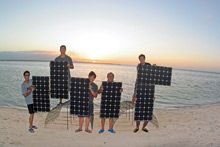Gerardo Jose la O’ spends most of his time building fuel cells for clean energy generation. But as a PhD student in the electrochemical-energy laboratory, he also knows batteries forwards and backwards. Now he’s tapping into that knowledge in order to help restore coral reefs in his native Philippines.

This January, la O’, whose funding came in part from the prize money his team received for winning the 2005-2006 MIT IDEAS Competition (web.mit.edu/ideas), led two MIT students to Sagay City and its neighboring reefs to install electric-powered coral-restoration devices called Biorocks, which are rebar rods assembled into a mesh and molded into reeflike shapes. Using electrical cables, the students connected the Biorocks to an anode and a power supply; then they placed them underwater where reefs had degraded. Direct electric current from the power supply causes calcium and carbon ions in the seawater to form calcium carbonate on the surface of the Biorocks, which act as cathodes. The calcium carbonate deposited is the same material that makes up corals’ hard skeletons, so coral larvae floating in the water land on the Biorocks and grow.
Developed in the 1970s as an alternative to passive reef restoration–which includes such methods as throwing tires in the water or leaving sunken ships undersea in the hopes that coral will grow on them–Biorock helps coral grow up to five times as fast as it would under normal conditions. One of its developers is Thomas J. Goreau ‘70, president of the Global Coral Reef Alliance. The MIT students’ innovation is to use renewable energy, rather than electricity from shore, to power the devices. One of their restoration sites relies on power from solar panels, the other on power from a wind turbine.
The coral reefs of the Philippines have greater biodiversity than the Great Barrier Reef; many kinds of fish find shelter and food in them. But the reefs are in grave danger of being destroyed by pollution and unsustainable fishing methods that use dynamite and poison. La O’ started the Biorock project, he says, to give something back to his home country. He hopes the reinvigoration of the coral reefs can help local fishermen and eventually attract ecotourism to the region.
Sagay City community members are currently monitoring the success of the restoration project, which la O’ says will be measured in terms of coral growth and fish activity at the sites. Back on land, la O’ says he is inspired by MIT’s motto, “Mind and Hand,” as he raises funds for the expansion of the restoration project and works on his fuel cells.
Keep Reading
Most Popular
Large language models can do jaw-dropping things. But nobody knows exactly why.
And that's a problem. Figuring it out is one of the biggest scientific puzzles of our time and a crucial step towards controlling more powerful future models.
The problem with plug-in hybrids? Their drivers.
Plug-in hybrids are often sold as a transition to EVs, but new data from Europe shows we’re still underestimating the emissions they produce.
Google DeepMind’s new generative model makes Super Mario–like games from scratch
Genie learns how to control games by watching hours and hours of video. It could help train next-gen robots too.
How scientists traced a mysterious covid case back to six toilets
When wastewater surveillance turns into a hunt for a single infected individual, the ethics get tricky.
Stay connected
Get the latest updates from
MIT Technology Review
Discover special offers, top stories, upcoming events, and more.